Telecommunication, media, and technology services giant AT&T (NYSE:T) has experienced substantial declines in the past five years (down 39%, not including dividends). The share price recently reached the lowest point in 12 years.
On May 17, 2021, the company announced a plan to spin off WarnerMedia in order to focus on broadband services. This is expected to occur in mid-2022.
AT&T will receive $43 billion for the WarnerMedia assets in the form of cash, debt securities, and the transfer for some debt with WarnerMedia. T reached a 12-month high close of $32.63, prior to the announcement, and has fallen 28% to reach the current level.
Given that AT&T purchased Time Warner slightly more than three years ago, along with the company’s poor performance since, it is hard to have confidence in AT&T’s management.
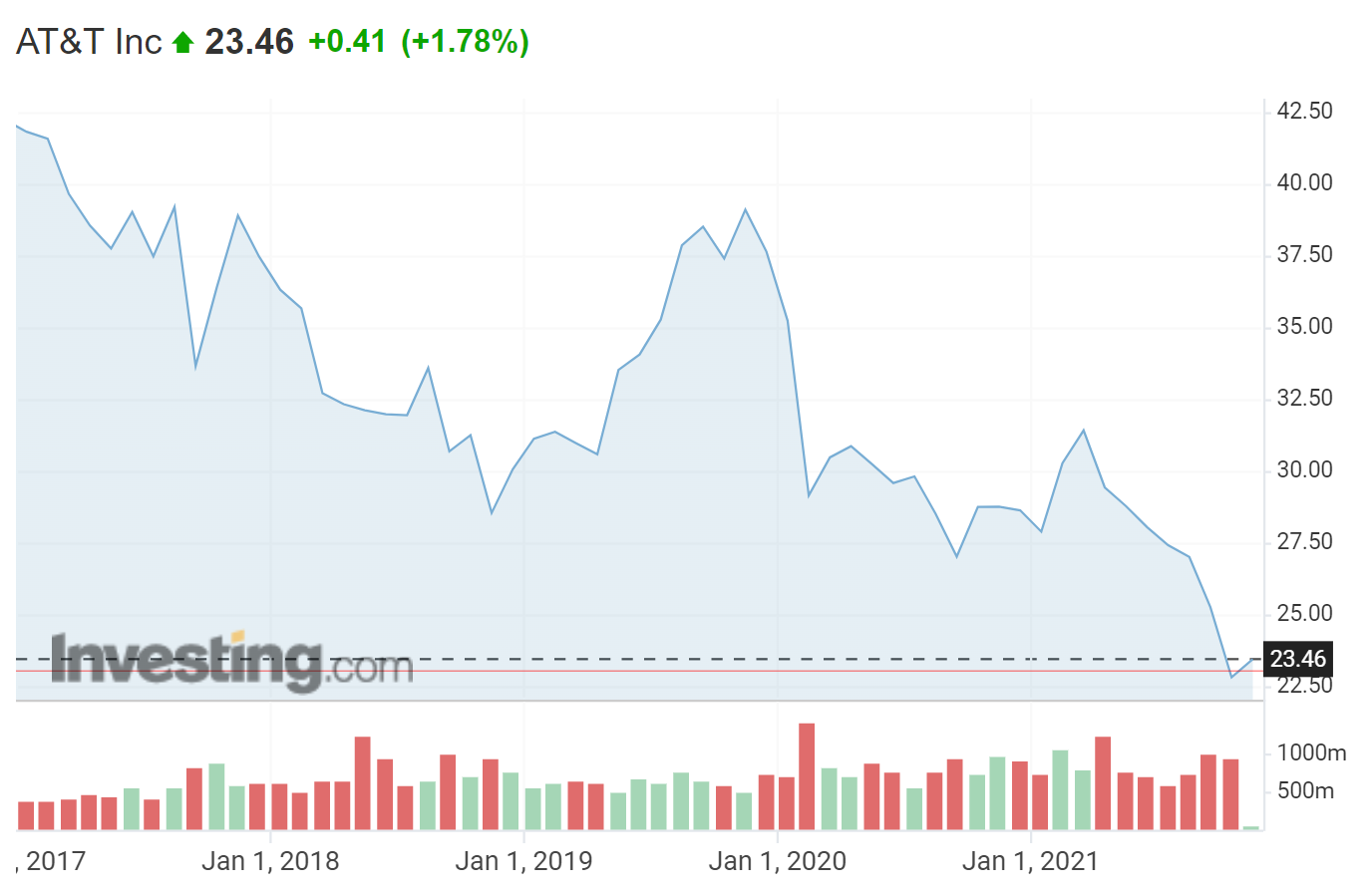
Source: Investing.com
After the spinoff is complete, T’s dividend is expected to be cut by 40%-50%. The anticipation of a dividend cut and general uncertainty about the spinoff has rattled investors. The current dividend yield of 9% and a forward P/E of 7.2 are of limited usefulness in evaluating T in advance of the spinoff.
The attractiveness of owning T depends substantially on projections about the growth potential of the new, smaller, AT&T, as well as for the new content giant created through the spinoff. In the past six months, the market has signaled a lack of confidence in AT&T’s prospects. Along with looking at current share price as a reflection of the market’s consensus estimate of the discounted future earnings, there are two other forms of consensus outlooks that are worth considering.
Most readers will be familiar with the Wall Street analyst consensus outlook for stocks. The consensus price target has been shown to have meaningful predictive value, as long as the dispersion among the individual price targets is not too high. Another form of consensus outlook for a stock can be derived from the prices of options on that stock.
The price of an option reflects the market’s consensus estimate of the probability that the share price will rise above (call option) or fall below (put option) a specific level (the option strike price) between now and when the option expires. By analysing the prices of calls and puts at a range of strike prices, all with the same expiration date, it is possible to calculate a probabilistic price forecast that reconciles the options prices. This is referred to as the market-implied outlook and represents the consensus of buyers and sellers of options.
I have calculated the market-implied outlooks for T to the middle of 2022 (calculated using options that expire on June 17, 2022), and to early 2023 (using options that expire on January 20, 2022), for comparison with the Wall Street analyst consensus outlook.
Wall Street Analyst Consensus Outlook For T
E-Trade calculates the Wall Street consensus using the views of 6 ranked analysts who have published ratings and 12-month price targets over the past 90 days. The consensus rating is neutral and the consensus 12-month price target is $30.29, 29.1% above the current share price.
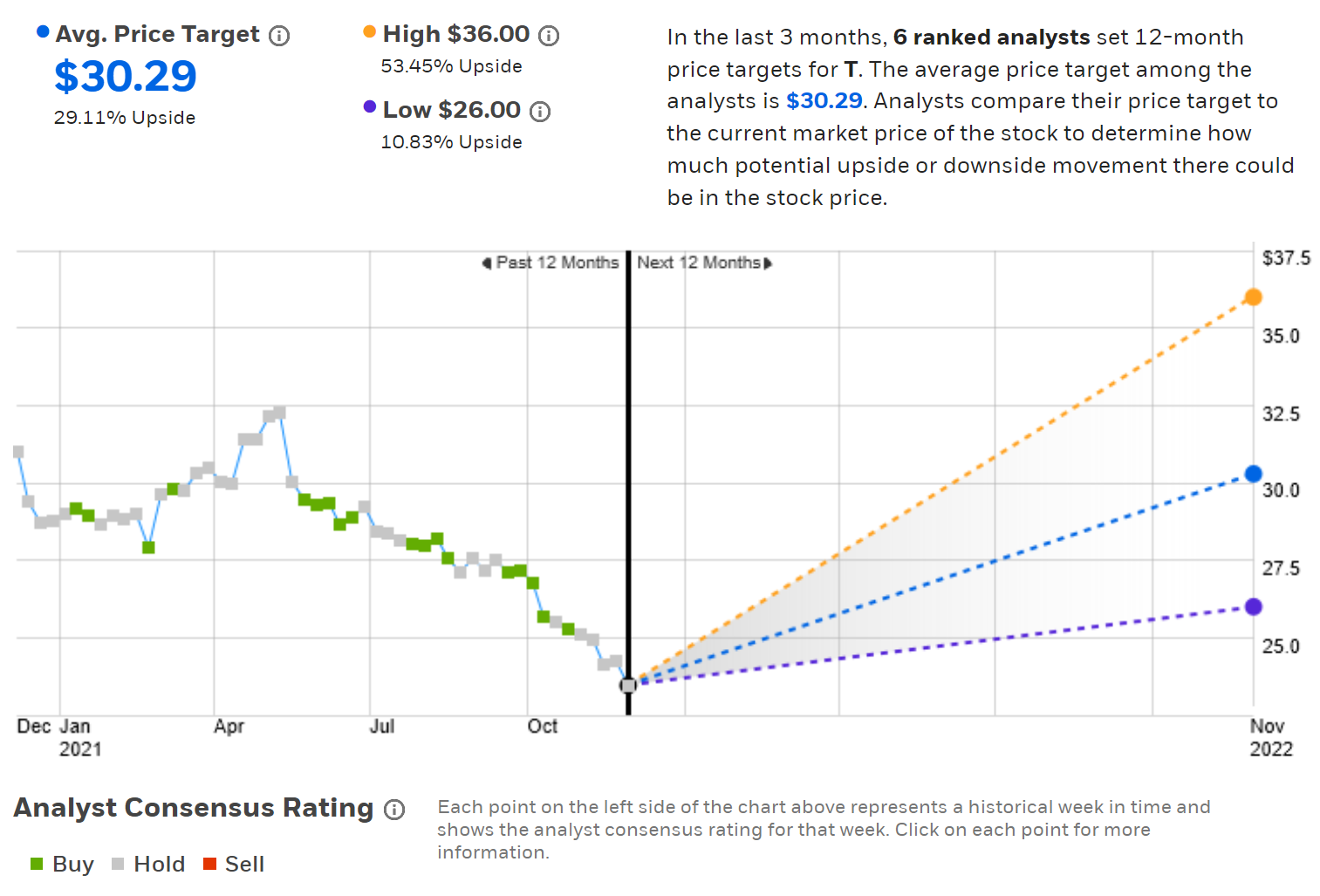
Source: E-Trade
Investing.com’s calculation of the Wall Street consensus combines outlooks from 30 analysts. The consensus rating is neutral and the 12-month price target is $30.70, providing a 30.9% upside versus the current share price.

Source: Investing.com
The two versions of the Wall Street consensus outlook, from E-Trade and from Investing.com, agree on a neutral outlook for T as well as providing price targets that imply expected price appreciation of 30% over the next 12 months. A neutral rating on a stock with 30% expected gain over the next year suggests that the analysts, in aggregate, are not optimistic about AT&T’s ability to grow, but view the current share price as oversold.
Market-Implied Outlook For T
I have analyzed options that expire on June 17, 2022 to calculate the market-implied outlook for the 6.4-month period from today until that date. I have also generated the 13.5-month outlook using options that expire on Jan. 20, 2023. The options expiring in January of 2023 provide the outlook period that is closest to one year.
The standard presentation of the market-implied outlook is in the form of a probability distribution of price return, with probability on the vertical axis and return on the horizontal.
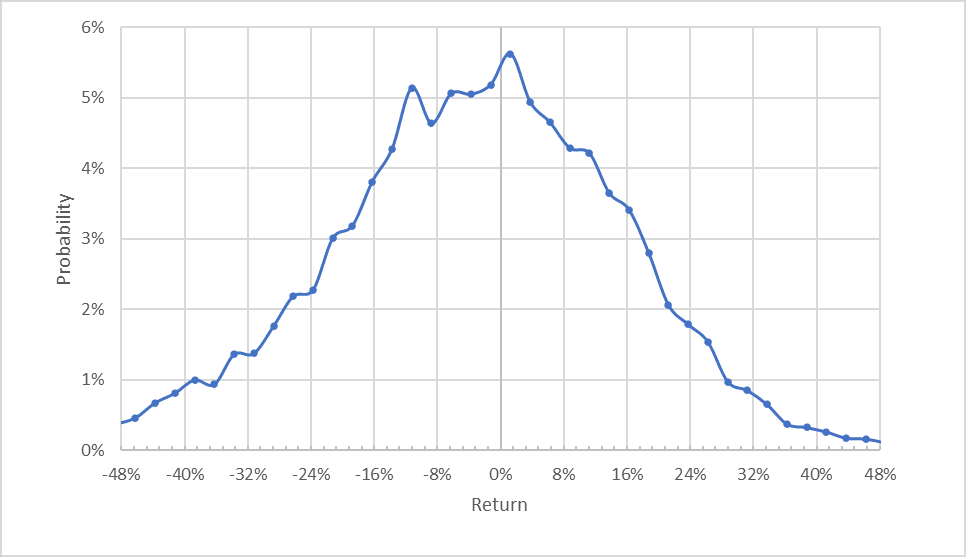
Market-implied price return probabilities for the 6.4-month period from today until June 17, 2022 (Source: Author’s calculations using options quotes from E-Trade)
The market-implied outlook to the middle of 2022 (around when the spinoff is supposed to be completed) is generally symmetric, with comparable probabilities of positive and negative returns. The annualized volatility calculated from this distribution is 34%.
To make it easier to directly compare the market-implied probabilities of positive and negative returns, I rotate the negative return side of the distribution about the vertical axis (see chart below).
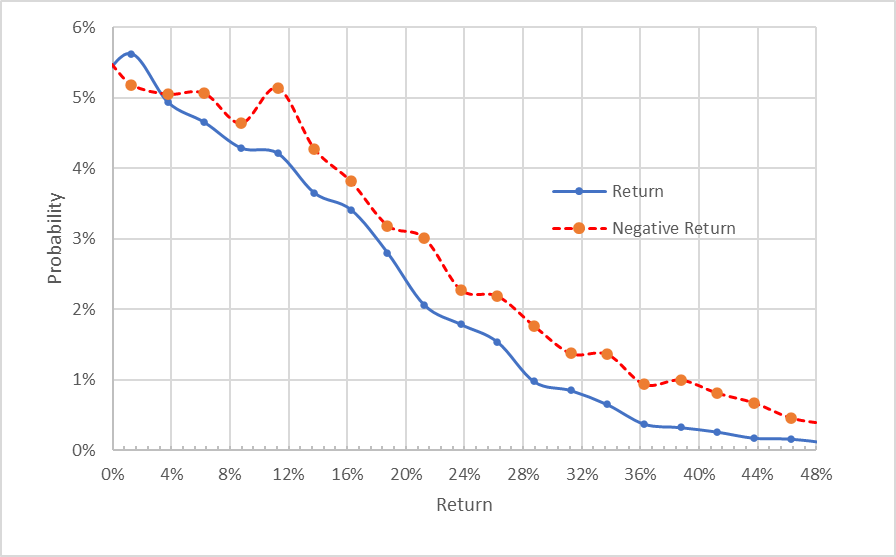
Market-implied price return probabilities for the 6.4-month period from today until June 17, 2022. The negative return side of the distribution has been rotated about the vertical axis (Source: Author’s calculations using options quotes from E-Trade)
From this view, what jumps out is the consistently higher probabilities of negative returns vs. positive returns of the same magnitude (the red dashed line is above the solid blue line across the distribution of outcomes).
Theory suggests that market-implied probabilities will tend to have a negative bias because investors tend to be risk averse and, as a result, pay more than fair value for downside protection (put options). There is no robust way to estimate the side of this potential bias. Considering the possibility of this bias, I interpret the market-implied outlook to the middle of 2022 to be neutral. There is nothing here to suggest that the options market favors any kind of price recovery.
Looking out to early 2023, with the market-implied outlook calculated from options expiring on June 17, 2023, the view has turned bearish. The probabilities of negative returns are now substantially higher relative to positive returns (the red dashed line is markedly higher than the solid blue line). The annualized volatility calculated from this distribution is 33%.
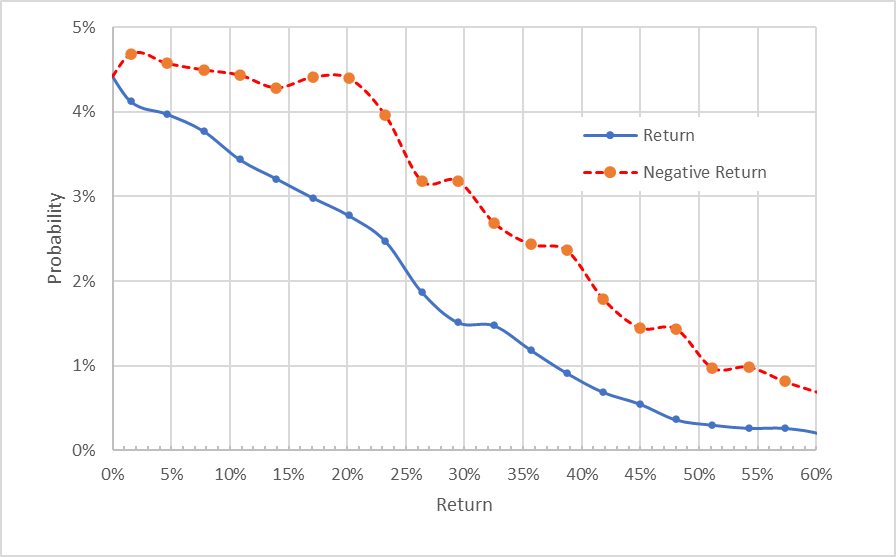
Market-implied price return probabilities for the 13.5-month period from today until June 17, 2022. The negative return side of the distribution has been rotated about the vertical axis (Source: Author’s calculations using options quotes from E-Trade)
The market-implied outlook for T is generally neutral to the middle of 2022, becoming bearish to early 2023. The consensus view from the options market favors price declines. The expected annualized volatility is about 33%.
Summary
The best argument for buying AT&T would be a belief that the market has miscalculated the underlying value of the company and that the shares have gotten oversold. This appears to be what the Wall Street consensus outlook indicates.
While the Wall Street consensus 12-month price target is 30% above the current share price, the consensus rating is neutral. Companies that have lost the faith or goodwill of the market can be profitable turnaround bets. Income investors, in particular, are likely to be disappointed in AT&T’s decisions. There is not much in the way of encouraging news from recent months.
The options trading activity on T is quite heavy. The market-implied outlook to the middle of 2022 is neutral, with expected volatility of about 34%. Looking through 2022 to January 2023, the 13.5-month outlook is bearish. It is certainly possible that T will have a near-term price recovery, bouncing off recent decade lows, but the longer view is not encouraging.
In balancing the analyst consensus opinion that the shares are oversold with the bearish view for the next year, my overall rating on T is neutral.
